Comparing 'Back to Basic' and 'Do Not Interrupt' Medication Approaches
VerifiedAdded on 2023/06/13
|8
|2234
|124
Report
AI Summary
This report provides a comparative analysis of the 'Back to Basic' and 'Do Not Interrupt' approaches to medication administration, both aimed at reducing medication errors in healthcare settings. The 'Back to Basic' approach focuses on reinforcing nurses' knowledge of medication administration procedures through educational interventions, tests, and surveys, while the 'Do Not Interrupt' approach seeks to minimize interruptions during medication administration through strategies like providing nurses with vests and educating both clinicians and patients. The report critiques the methodologies of studies evaluating these approaches, including sample sizes, study durations, and the validity of the methods used. It concludes that both approaches contribute to improving patient safety, with the 'Do Not Interrupt' method potentially having a more significant impact by addressing the factors that often precede medication errors. Ultimately, the report emphasizes the importance of continuous education, improved working conditions, and the reporting of medication errors to enhance medication safety practices. Desklib offers a wealth of similar reports and study resources for students.
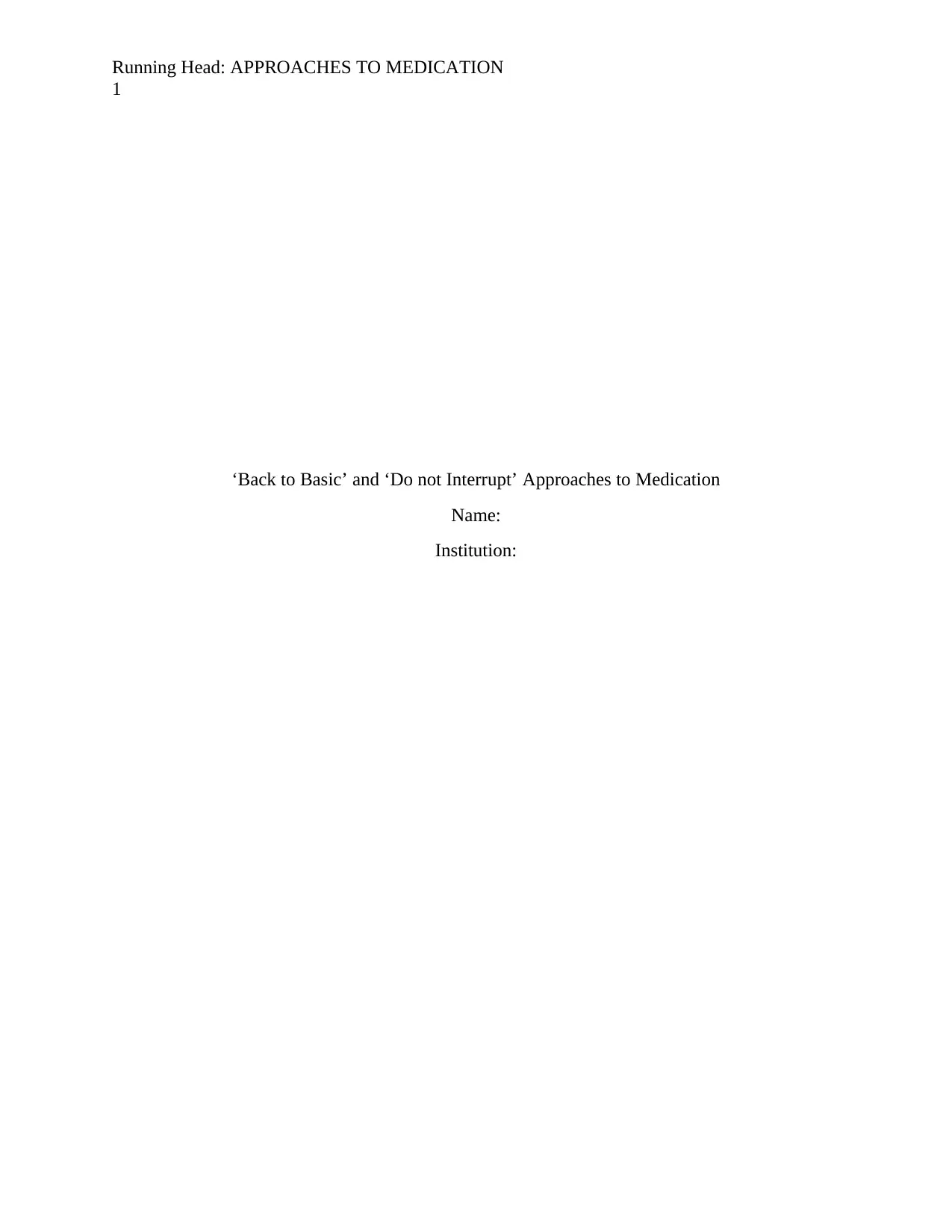
Running Head: APPROACHES TO MEDICATION
1
‘Back to Basic’ and ‘Do not Interrupt’ Approaches to Medication
Name:
Institution:
1
‘Back to Basic’ and ‘Do not Interrupt’ Approaches to Medication
Name:
Institution:
Paraphrase This Document
Need a fresh take? Get an instant paraphrase of this document with our AI Paraphraser
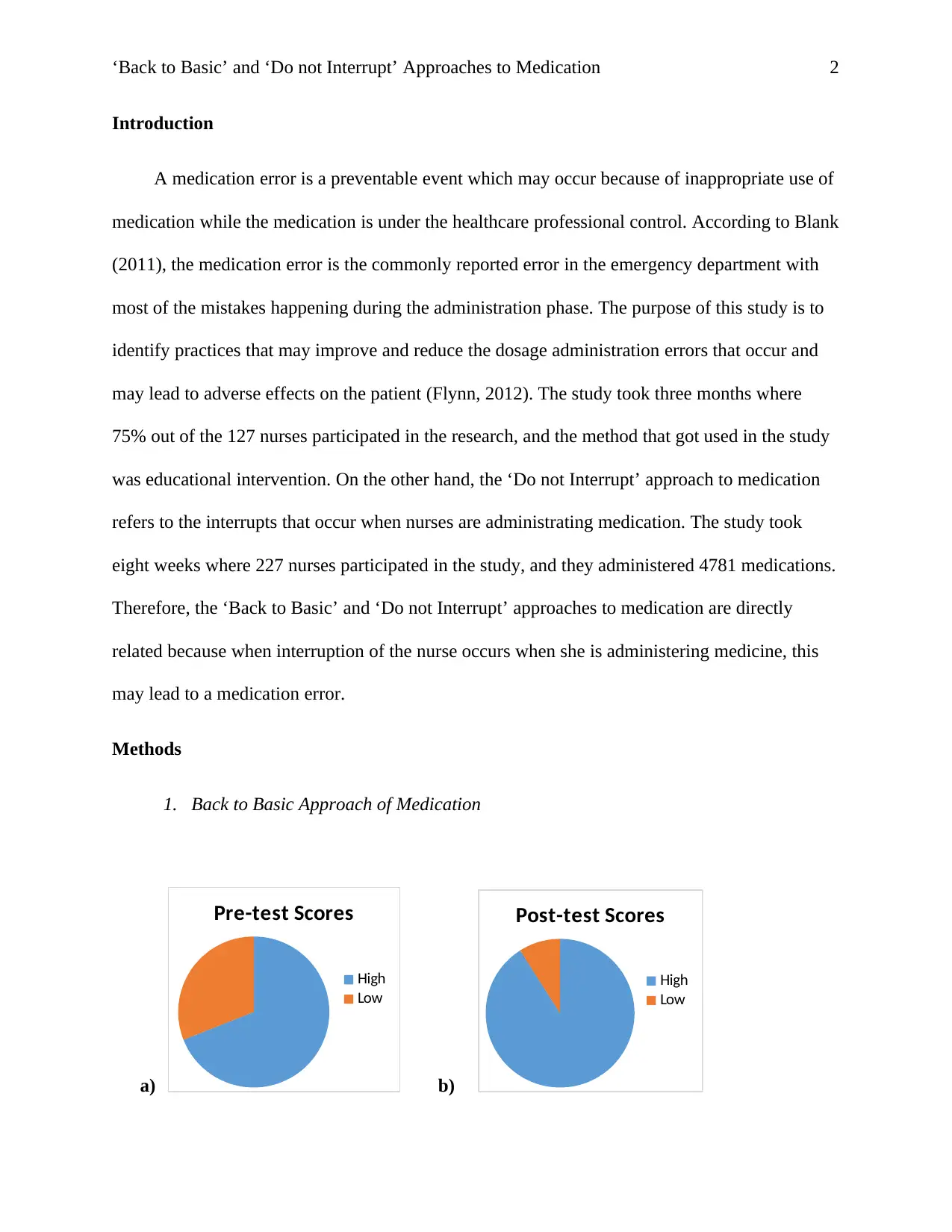
‘Back to Basic’ and ‘Do not Interrupt’ Approaches to Medication 2
Introduction
A medication error is a preventable event which may occur because of inappropriate use of
medication while the medication is under the healthcare professional control. According to Blank
(2011), the medication error is the commonly reported error in the emergency department with
most of the mistakes happening during the administration phase. The purpose of this study is to
identify practices that may improve and reduce the dosage administration errors that occur and
may lead to adverse effects on the patient (Flynn, 2012). The study took three months where
75% out of the 127 nurses participated in the research, and the method that got used in the study
was educational intervention. On the other hand, the ‘Do not Interrupt’ approach to medication
refers to the interrupts that occur when nurses are administrating medication. The study took
eight weeks where 227 nurses participated in the study, and they administered 4781 medications.
Therefore, the ‘Back to Basic’ and ‘Do not Interrupt’ approaches to medication are directly
related because when interruption of the nurse occurs when she is administering medicine, this
may lead to a medication error.
Methods
1. Back to Basic Approach of Medication
a)
Pre-test Scores
High
Low
b)
Post-test Scores
High
Low
Introduction
A medication error is a preventable event which may occur because of inappropriate use of
medication while the medication is under the healthcare professional control. According to Blank
(2011), the medication error is the commonly reported error in the emergency department with
most of the mistakes happening during the administration phase. The purpose of this study is to
identify practices that may improve and reduce the dosage administration errors that occur and
may lead to adverse effects on the patient (Flynn, 2012). The study took three months where
75% out of the 127 nurses participated in the research, and the method that got used in the study
was educational intervention. On the other hand, the ‘Do not Interrupt’ approach to medication
refers to the interrupts that occur when nurses are administrating medication. The study took
eight weeks where 227 nurses participated in the study, and they administered 4781 medications.
Therefore, the ‘Back to Basic’ and ‘Do not Interrupt’ approaches to medication are directly
related because when interruption of the nurse occurs when she is administering medicine, this
may lead to a medication error.
Methods
1. Back to Basic Approach of Medication
a)
Pre-test Scores
High
Low
b)
Post-test Scores
High
Low
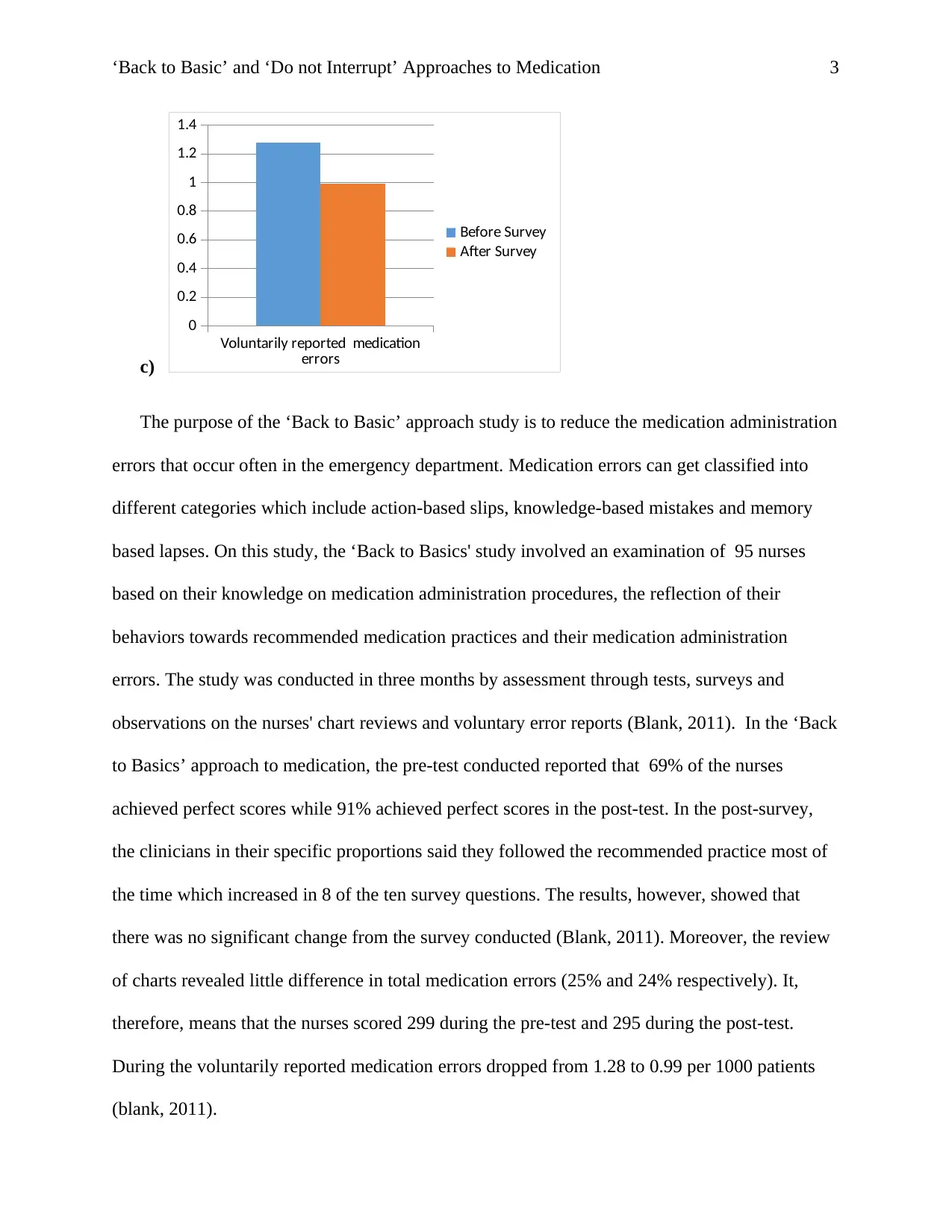
‘Back to Basic’ and ‘Do not Interrupt’ Approaches to Medication 3
c)
Voluntarily reported medication
errors
0
0.2
0.4
0.6
0.8
1
1.2
1.4
Before Survey
After Survey
The purpose of the ‘Back to Basic’ approach study is to reduce the medication administration
errors that occur often in the emergency department. Medication errors can get classified into
different categories which include action-based slips, knowledge-based mistakes and memory
based lapses. On this study, the ‘Back to Basics' study involved an examination of 95 nurses
based on their knowledge on medication administration procedures, the reflection of their
behaviors towards recommended medication practices and their medication administration
errors. The study was conducted in three months by assessment through tests, surveys and
observations on the nurses' chart reviews and voluntary error reports (Blank, 2011). In the ‘Back
to Basics’ approach to medication, the pre-test conducted reported that 69% of the nurses
achieved perfect scores while 91% achieved perfect scores in the post-test. In the post-survey,
the clinicians in their specific proportions said they followed the recommended practice most of
the time which increased in 8 of the ten survey questions. The results, however, showed that
there was no significant change from the survey conducted (Blank, 2011). Moreover, the review
of charts revealed little difference in total medication errors (25% and 24% respectively). It,
therefore, means that the nurses scored 299 during the pre-test and 295 during the post-test.
During the voluntarily reported medication errors dropped from 1.28 to 0.99 per 1000 patients
(blank, 2011).
c)
Voluntarily reported medication
errors
0
0.2
0.4
0.6
0.8
1
1.2
1.4
Before Survey
After Survey
The purpose of the ‘Back to Basic’ approach study is to reduce the medication administration
errors that occur often in the emergency department. Medication errors can get classified into
different categories which include action-based slips, knowledge-based mistakes and memory
based lapses. On this study, the ‘Back to Basics' study involved an examination of 95 nurses
based on their knowledge on medication administration procedures, the reflection of their
behaviors towards recommended medication practices and their medication administration
errors. The study was conducted in three months by assessment through tests, surveys and
observations on the nurses' chart reviews and voluntary error reports (Blank, 2011). In the ‘Back
to Basics’ approach to medication, the pre-test conducted reported that 69% of the nurses
achieved perfect scores while 91% achieved perfect scores in the post-test. In the post-survey,
the clinicians in their specific proportions said they followed the recommended practice most of
the time which increased in 8 of the ten survey questions. The results, however, showed that
there was no significant change from the survey conducted (Blank, 2011). Moreover, the review
of charts revealed little difference in total medication errors (25% and 24% respectively). It,
therefore, means that the nurses scored 299 during the pre-test and 295 during the post-test.
During the voluntarily reported medication errors dropped from 1.28 to 0.99 per 1000 patients
(blank, 2011).
⊘ This is a preview!⊘
Do you want full access?
Subscribe today to unlock all pages.

Trusted by 1+ million students worldwide
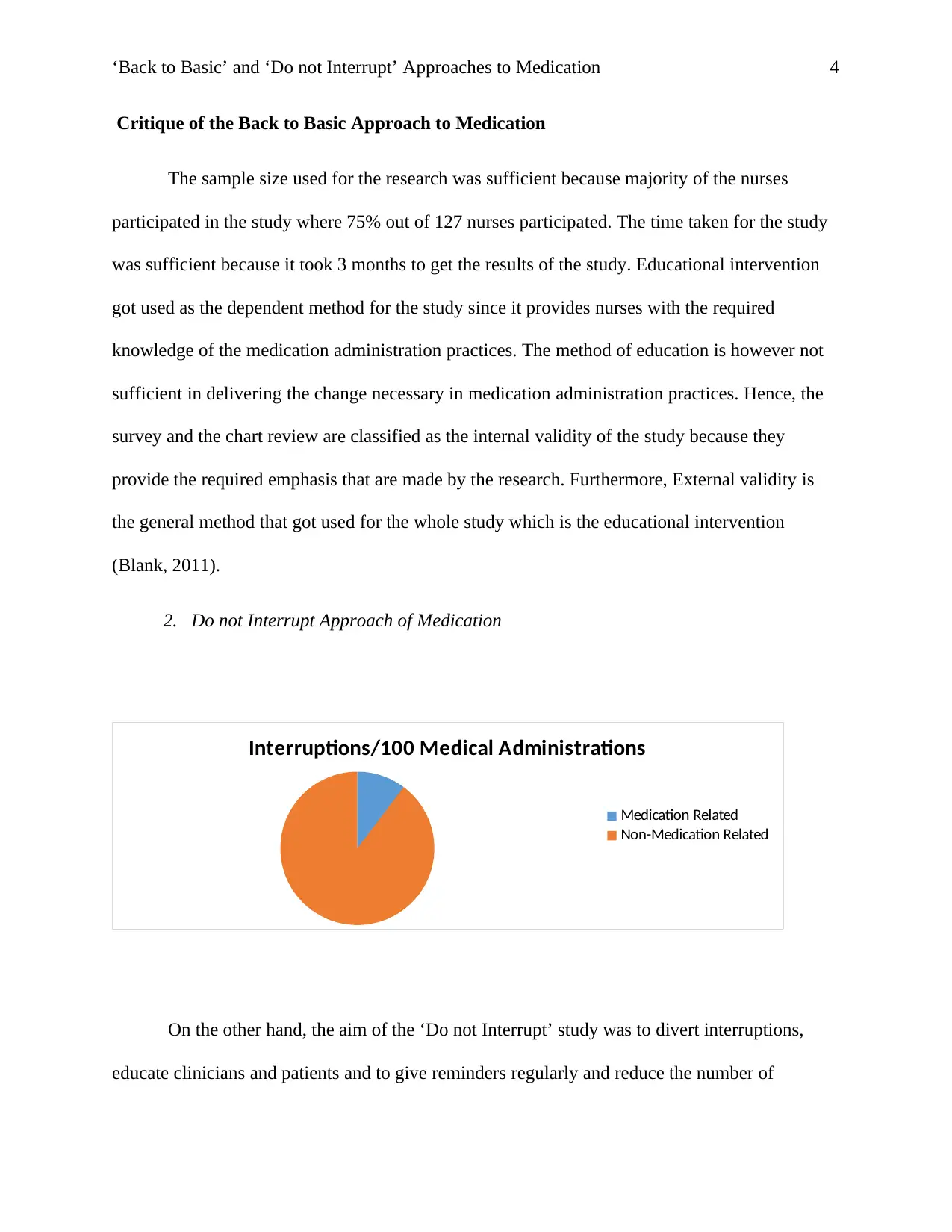
‘Back to Basic’ and ‘Do not Interrupt’ Approaches to Medication 4
Critique of the Back to Basic Approach to Medication
The sample size used for the research was sufficient because majority of the nurses
participated in the study where 75% out of 127 nurses participated. The time taken for the study
was sufficient because it took 3 months to get the results of the study. Educational intervention
got used as the dependent method for the study since it provides nurses with the required
knowledge of the medication administration practices. The method of education is however not
sufficient in delivering the change necessary in medication administration practices. Hence, the
survey and the chart review are classified as the internal validity of the study because they
provide the required emphasis that are made by the research. Furthermore, External validity is
the general method that got used for the whole study which is the educational intervention
(Blank, 2011).
2. Do not Interrupt Approach of Medication
Interruptions/100 Medical Administrations
Medication Related
Non-Medication Related
On the other hand, the aim of the ‘Do not Interrupt’ study was to divert interruptions,
educate clinicians and patients and to give reminders regularly and reduce the number of
Critique of the Back to Basic Approach to Medication
The sample size used for the research was sufficient because majority of the nurses
participated in the study where 75% out of 127 nurses participated. The time taken for the study
was sufficient because it took 3 months to get the results of the study. Educational intervention
got used as the dependent method for the study since it provides nurses with the required
knowledge of the medication administration practices. The method of education is however not
sufficient in delivering the change necessary in medication administration practices. Hence, the
survey and the chart review are classified as the internal validity of the study because they
provide the required emphasis that are made by the research. Furthermore, External validity is
the general method that got used for the whole study which is the educational intervention
(Blank, 2011).
2. Do not Interrupt Approach of Medication
Interruptions/100 Medical Administrations
Medication Related
Non-Medication Related
On the other hand, the aim of the ‘Do not Interrupt’ study was to divert interruptions,
educate clinicians and patients and to give reminders regularly and reduce the number of
Paraphrase This Document
Need a fresh take? Get an instant paraphrase of this document with our AI Paraphraser
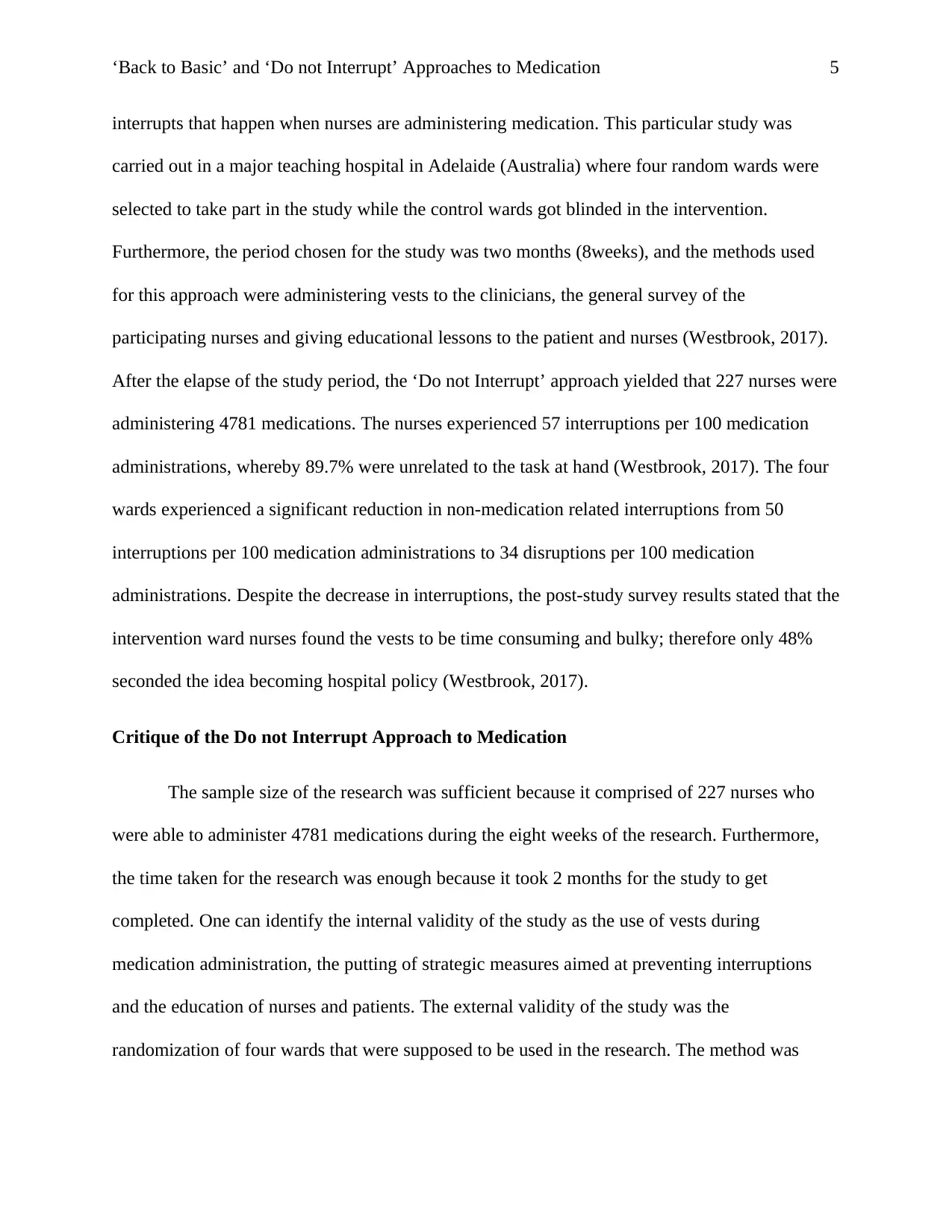
‘Back to Basic’ and ‘Do not Interrupt’ Approaches to Medication 5
interrupts that happen when nurses are administering medication. This particular study was
carried out in a major teaching hospital in Adelaide (Australia) where four random wards were
selected to take part in the study while the control wards got blinded in the intervention.
Furthermore, the period chosen for the study was two months (8weeks), and the methods used
for this approach were administering vests to the clinicians, the general survey of the
participating nurses and giving educational lessons to the patient and nurses (Westbrook, 2017).
After the elapse of the study period, the ‘Do not Interrupt’ approach yielded that 227 nurses were
administering 4781 medications. The nurses experienced 57 interruptions per 100 medication
administrations, whereby 89.7% were unrelated to the task at hand (Westbrook, 2017). The four
wards experienced a significant reduction in non-medication related interruptions from 50
interruptions per 100 medication administrations to 34 disruptions per 100 medication
administrations. Despite the decrease in interruptions, the post-study survey results stated that the
intervention ward nurses found the vests to be time consuming and bulky; therefore only 48%
seconded the idea becoming hospital policy (Westbrook, 2017).
Critique of the Do not Interrupt Approach to Medication
The sample size of the research was sufficient because it comprised of 227 nurses who
were able to administer 4781 medications during the eight weeks of the research. Furthermore,
the time taken for the research was enough because it took 2 months for the study to get
completed. One can identify the internal validity of the study as the use of vests during
medication administration, the putting of strategic measures aimed at preventing interruptions
and the education of nurses and patients. The external validity of the study was the
randomization of four wards that were supposed to be used in the research. The method was
interrupts that happen when nurses are administering medication. This particular study was
carried out in a major teaching hospital in Adelaide (Australia) where four random wards were
selected to take part in the study while the control wards got blinded in the intervention.
Furthermore, the period chosen for the study was two months (8weeks), and the methods used
for this approach were administering vests to the clinicians, the general survey of the
participating nurses and giving educational lessons to the patient and nurses (Westbrook, 2017).
After the elapse of the study period, the ‘Do not Interrupt’ approach yielded that 227 nurses were
administering 4781 medications. The nurses experienced 57 interruptions per 100 medication
administrations, whereby 89.7% were unrelated to the task at hand (Westbrook, 2017). The four
wards experienced a significant reduction in non-medication related interruptions from 50
interruptions per 100 medication administrations to 34 disruptions per 100 medication
administrations. Despite the decrease in interruptions, the post-study survey results stated that the
intervention ward nurses found the vests to be time consuming and bulky; therefore only 48%
seconded the idea becoming hospital policy (Westbrook, 2017).
Critique of the Do not Interrupt Approach to Medication
The sample size of the research was sufficient because it comprised of 227 nurses who
were able to administer 4781 medications during the eight weeks of the research. Furthermore,
the time taken for the research was enough because it took 2 months for the study to get
completed. One can identify the internal validity of the study as the use of vests during
medication administration, the putting of strategic measures aimed at preventing interruptions
and the education of nurses and patients. The external validity of the study was the
randomization of four wards that were supposed to be used in the research. The method was

‘Back to Basic’ and ‘Do not Interrupt’ Approaches to Medication 6
however not seen as sufficient because only 48% of the nurses applauded it to become a hospital
policy (Westbrook, 2017).
Comparison of the Two Approaches to Medication
These two approaches of medication go hand in hand in that through the reduction of the
number of interruptions during operations; medical personnel can focus solely on medication
administration which eventually reduces the medication errors. According to Blank (2011), the
“Back to Basics” approach improves the nurses’ knowledge of the recommended medication
administration practices. Inadequate knowledge, incomplete information about clinical
characteristics and the lack of previous patient records can result in prescribing inappropriate
medications. For instance, some infants died to an overdose of heparin drugs due to the wrong
labeling of the medicine and the bad packaging of the medicine which resulted to the medication
error that caused the death of the infants (Anderson, 2010). Another example is when the
clinician prescribes penicillin without having established whether the patient is allergic or not.
This means that the ‘Do not Interrupt’ approach of medication is the most significant compared
to the ‘Back to Basic’ approach because it often happens before the medication error occurs. This
means the dosage error must occur for the medication error to happen which is the ‘Back to
Basic error’. Moreover, the insufficient nurse experience may lead to medication errors where
the nurse does not know the required dosage for a specific drug and this may lead to wrong
prescriptions that may be fatal to a patient. Therefore, when the nurse has adequate skill and
experience in their particular fields such errors may be avoided because the nurse knows the
required dosage a patient should take (Karavasiliadou, 2014). Furthermore, the lack of sufficient
protocol regarding the arrival time of medicines to the hospital may lead to late medication
administration (Karavasiliadou, 2014). Observations made indicate that the rate at which
however not seen as sufficient because only 48% of the nurses applauded it to become a hospital
policy (Westbrook, 2017).
Comparison of the Two Approaches to Medication
These two approaches of medication go hand in hand in that through the reduction of the
number of interruptions during operations; medical personnel can focus solely on medication
administration which eventually reduces the medication errors. According to Blank (2011), the
“Back to Basics” approach improves the nurses’ knowledge of the recommended medication
administration practices. Inadequate knowledge, incomplete information about clinical
characteristics and the lack of previous patient records can result in prescribing inappropriate
medications. For instance, some infants died to an overdose of heparin drugs due to the wrong
labeling of the medicine and the bad packaging of the medicine which resulted to the medication
error that caused the death of the infants (Anderson, 2010). Another example is when the
clinician prescribes penicillin without having established whether the patient is allergic or not.
This means that the ‘Do not Interrupt’ approach of medication is the most significant compared
to the ‘Back to Basic’ approach because it often happens before the medication error occurs. This
means the dosage error must occur for the medication error to happen which is the ‘Back to
Basic error’. Moreover, the insufficient nurse experience may lead to medication errors where
the nurse does not know the required dosage for a specific drug and this may lead to wrong
prescriptions that may be fatal to a patient. Therefore, when the nurse has adequate skill and
experience in their particular fields such errors may be avoided because the nurse knows the
required dosage a patient should take (Karavasiliadou, 2014). Furthermore, the lack of sufficient
protocol regarding the arrival time of medicines to the hospital may lead to late medication
administration (Karavasiliadou, 2014). Observations made indicate that the rate at which
⊘ This is a preview!⊘
Do you want full access?
Subscribe today to unlock all pages.

Trusted by 1+ million students worldwide
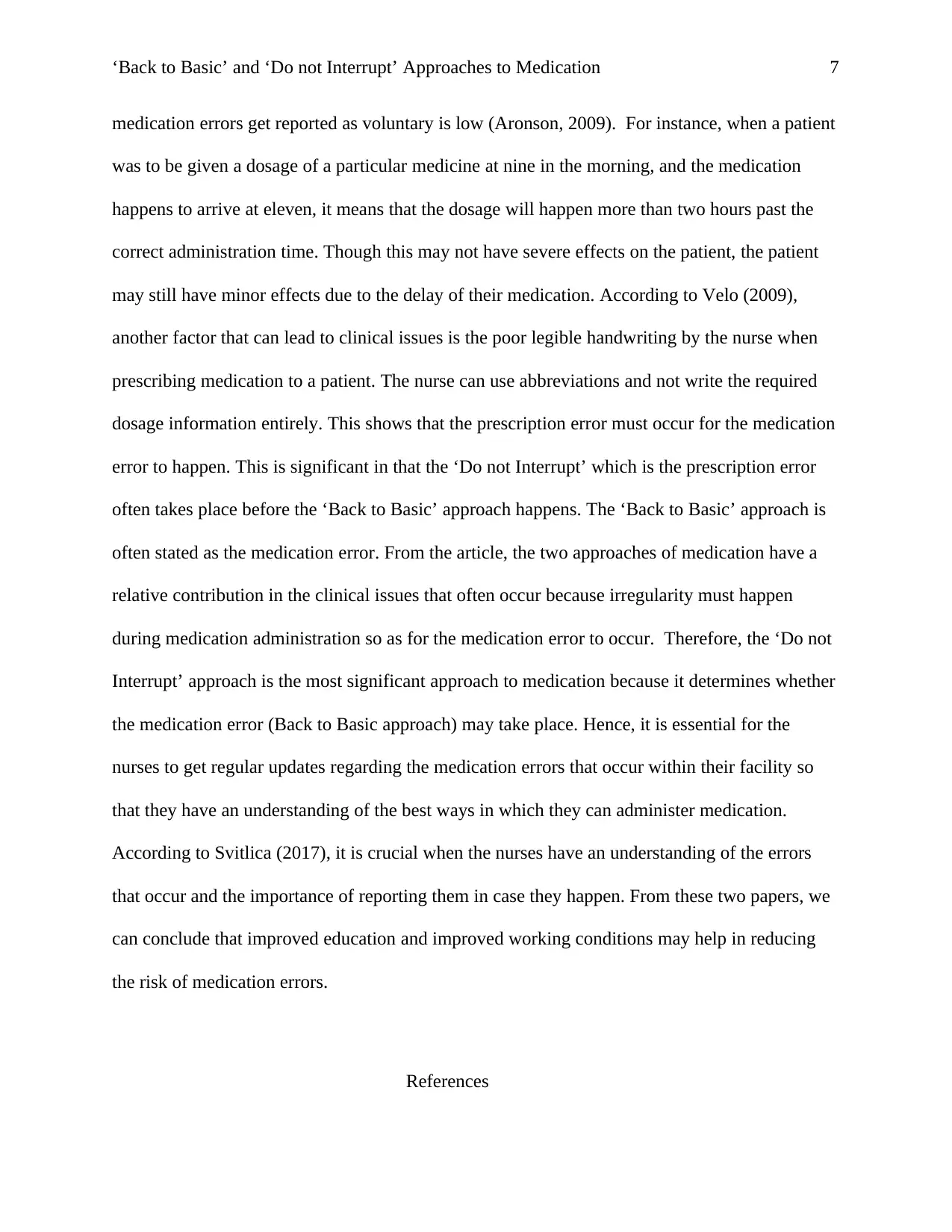
‘Back to Basic’ and ‘Do not Interrupt’ Approaches to Medication 7
medication errors get reported as voluntary is low (Aronson, 2009). For instance, when a patient
was to be given a dosage of a particular medicine at nine in the morning, and the medication
happens to arrive at eleven, it means that the dosage will happen more than two hours past the
correct administration time. Though this may not have severe effects on the patient, the patient
may still have minor effects due to the delay of their medication. According to Velo (2009),
another factor that can lead to clinical issues is the poor legible handwriting by the nurse when
prescribing medication to a patient. The nurse can use abbreviations and not write the required
dosage information entirely. This shows that the prescription error must occur for the medication
error to happen. This is significant in that the ‘Do not Interrupt’ which is the prescription error
often takes place before the ‘Back to Basic’ approach happens. The ‘Back to Basic’ approach is
often stated as the medication error. From the article, the two approaches of medication have a
relative contribution in the clinical issues that often occur because irregularity must happen
during medication administration so as for the medication error to occur. Therefore, the ‘Do not
Interrupt’ approach is the most significant approach to medication because it determines whether
the medication error (Back to Basic approach) may take place. Hence, it is essential for the
nurses to get regular updates regarding the medication errors that occur within their facility so
that they have an understanding of the best ways in which they can administer medication.
According to Svitlica (2017), it is crucial when the nurses have an understanding of the errors
that occur and the importance of reporting them in case they happen. From these two papers, we
can conclude that improved education and improved working conditions may help in reducing
the risk of medication errors.
References
medication errors get reported as voluntary is low (Aronson, 2009). For instance, when a patient
was to be given a dosage of a particular medicine at nine in the morning, and the medication
happens to arrive at eleven, it means that the dosage will happen more than two hours past the
correct administration time. Though this may not have severe effects on the patient, the patient
may still have minor effects due to the delay of their medication. According to Velo (2009),
another factor that can lead to clinical issues is the poor legible handwriting by the nurse when
prescribing medication to a patient. The nurse can use abbreviations and not write the required
dosage information entirely. This shows that the prescription error must occur for the medication
error to happen. This is significant in that the ‘Do not Interrupt’ which is the prescription error
often takes place before the ‘Back to Basic’ approach happens. The ‘Back to Basic’ approach is
often stated as the medication error. From the article, the two approaches of medication have a
relative contribution in the clinical issues that often occur because irregularity must happen
during medication administration so as for the medication error to occur. Therefore, the ‘Do not
Interrupt’ approach is the most significant approach to medication because it determines whether
the medication error (Back to Basic approach) may take place. Hence, it is essential for the
nurses to get regular updates regarding the medication errors that occur within their facility so
that they have an understanding of the best ways in which they can administer medication.
According to Svitlica (2017), it is crucial when the nurses have an understanding of the errors
that occur and the importance of reporting them in case they happen. From these two papers, we
can conclude that improved education and improved working conditions may help in reducing
the risk of medication errors.
References
Paraphrase This Document
Need a fresh take? Get an instant paraphrase of this document with our AI Paraphraser

‘Back to Basic’ and ‘Do not Interrupt’ Approaches to Medication 8
Anderson, P., Townsend, T., & CCRN-CMC, C. B. (2010). Medication errors. American Nurse
Today, 23-27.
Aronson,J.K. (2009) Medication errors: what they are, how they happen, and how to avoid them.
QJM: An International Journal of Medicine, Volume 102, Issue 8, 1 August 2009,
Pages 513-521,https;//doi.org/10.1093/qjmed/hcpo52
Blank,F.S.J.,Tobin,J.,Macomber,S.,Jaouen,M.,Dinoia,M.,&Visintainer,P.(2011).A “Back to
Basics” Approach to Reduce ED Medication Errors. JEN: Journal of Emergency
Nursing, 37(2), 141-147.doi:10.1016/j.jen.2009.11.026
Flynn, L., Liang, Y., Dickson, G. L., Xie, M., & Suh, D. C. (2012). Nurses’ practice
environments, error interception practices, and inpatient medication errors. Journal of
Nursing Scholarship, 44(2), 180-186.
Karavasiliadou, S., & Athanasakis, E. (2014). An inside look into the factors contributing to
medication errors in the clinical nursing practice. Health science journal, 8(1).
Svitlica, B. B., Simin, D., & Milutinović, D. (2017). Potential causes of medication errors:
perceptions of Serbian nurses. International nursing review, 64(3), 421-427.
Westbrook,J.I.,Ling,L.,Hopper,T.D.,Raban,M.Z.,Middleton,S.,&Lehnbom.E.C.
(2017).Effectiveness of a ‘Do not interrupt’ hundled intervention to reduce
interruptions during medication administration: a cluster randomized controlled
feasibility study
Velo G.P, Minuz,P. (2009) -British journey of clinical pharmacology, Medication errors:
Prescribing faults and prescription errors. Academic Emergency Medicine 7(11),
1239-1243, 2000
Anderson, P., Townsend, T., & CCRN-CMC, C. B. (2010). Medication errors. American Nurse
Today, 23-27.
Aronson,J.K. (2009) Medication errors: what they are, how they happen, and how to avoid them.
QJM: An International Journal of Medicine, Volume 102, Issue 8, 1 August 2009,
Pages 513-521,https;//doi.org/10.1093/qjmed/hcpo52
Blank,F.S.J.,Tobin,J.,Macomber,S.,Jaouen,M.,Dinoia,M.,&Visintainer,P.(2011).A “Back to
Basics” Approach to Reduce ED Medication Errors. JEN: Journal of Emergency
Nursing, 37(2), 141-147.doi:10.1016/j.jen.2009.11.026
Flynn, L., Liang, Y., Dickson, G. L., Xie, M., & Suh, D. C. (2012). Nurses’ practice
environments, error interception practices, and inpatient medication errors. Journal of
Nursing Scholarship, 44(2), 180-186.
Karavasiliadou, S., & Athanasakis, E. (2014). An inside look into the factors contributing to
medication errors in the clinical nursing practice. Health science journal, 8(1).
Svitlica, B. B., Simin, D., & Milutinović, D. (2017). Potential causes of medication errors:
perceptions of Serbian nurses. International nursing review, 64(3), 421-427.
Westbrook,J.I.,Ling,L.,Hopper,T.D.,Raban,M.Z.,Middleton,S.,&Lehnbom.E.C.
(2017).Effectiveness of a ‘Do not interrupt’ hundled intervention to reduce
interruptions during medication administration: a cluster randomized controlled
feasibility study
Velo G.P, Minuz,P. (2009) -British journey of clinical pharmacology, Medication errors:
Prescribing faults and prescription errors. Academic Emergency Medicine 7(11),
1239-1243, 2000
1 out of 8
Related Documents
Your All-in-One AI-Powered Toolkit for Academic Success.
+13062052269
info@desklib.com
Available 24*7 on WhatsApp / Email
![[object Object]](/_next/static/media/star-bottom.7253800d.svg)
Unlock your academic potential
Copyright © 2020–2025 A2Z Services. All Rights Reserved. Developed and managed by ZUCOL.




